Nursing Report: Analysis of Interpersonal Communication in Practice
VerifiedAdded on 2020/03/23
|5
|1493
|60
Report
AI Summary
This report analyzes the importance of effective interpersonal communication in nursing practice, highlighting its impact on patient safety and professional conduct. The author reflects on two key interactions: an interview with a mentally ill patient and training sessions for new nurses. The analysis reveals strengths in insightfulness, verbal expression, listening skills, and emotional management, while identifying a weakness in assertiveness. The report details the use of role-playing and online interpersonal skill tests to assess and improve communication abilities. The author sets goals to enhance assertiveness through a time-bound, stepwise approach, emphasizing the importance of understanding different perspectives and incorporating ethical choices in interactions. The conclusion stresses the significance of effective communication in providing holistic patient care and fostering a positive healthcare environment. References from various research papers are also provided.
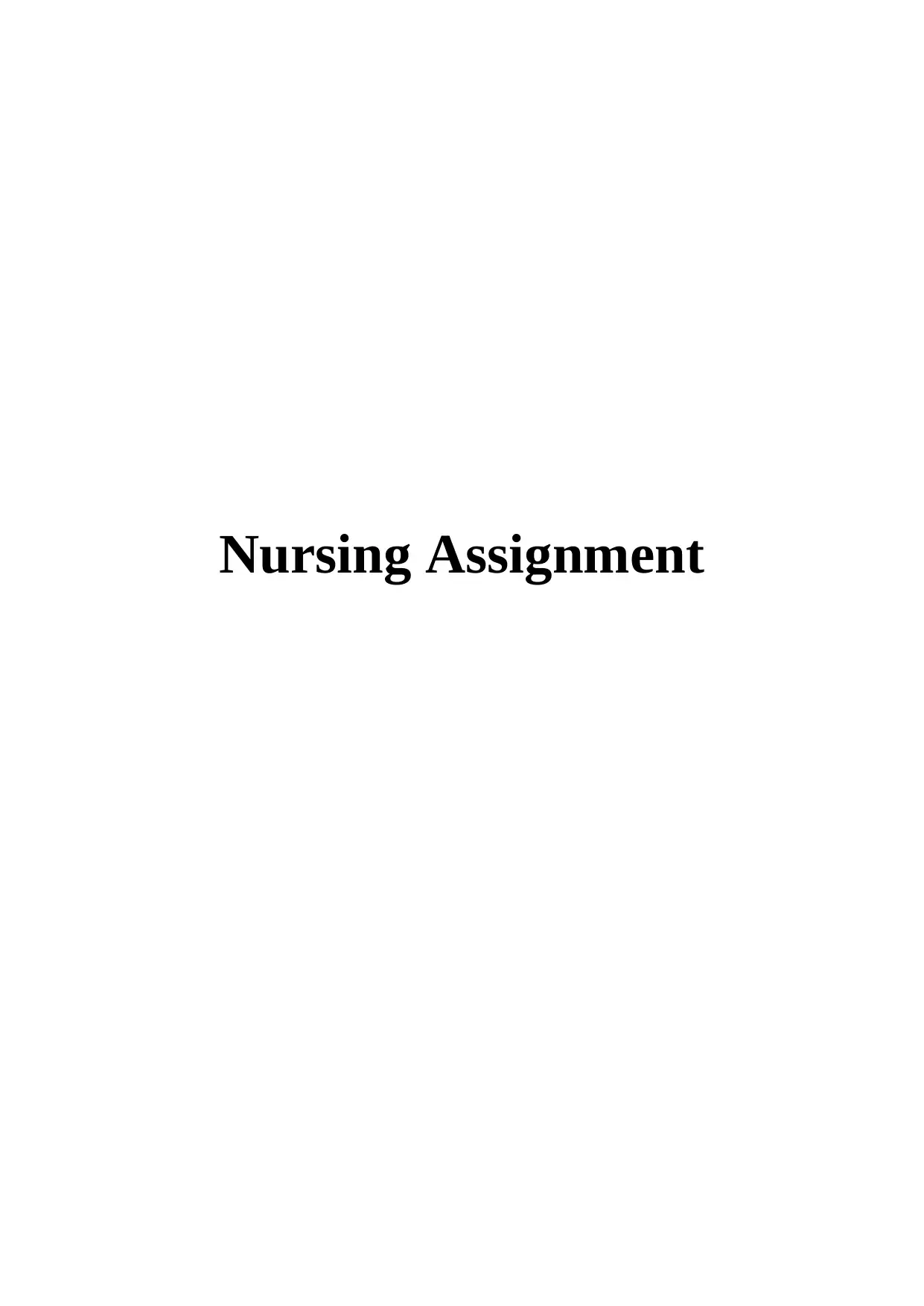
Nursing Assignment
Paraphrase This Document
Need a fresh take? Get an instant paraphrase of this document with our AI Paraphraser
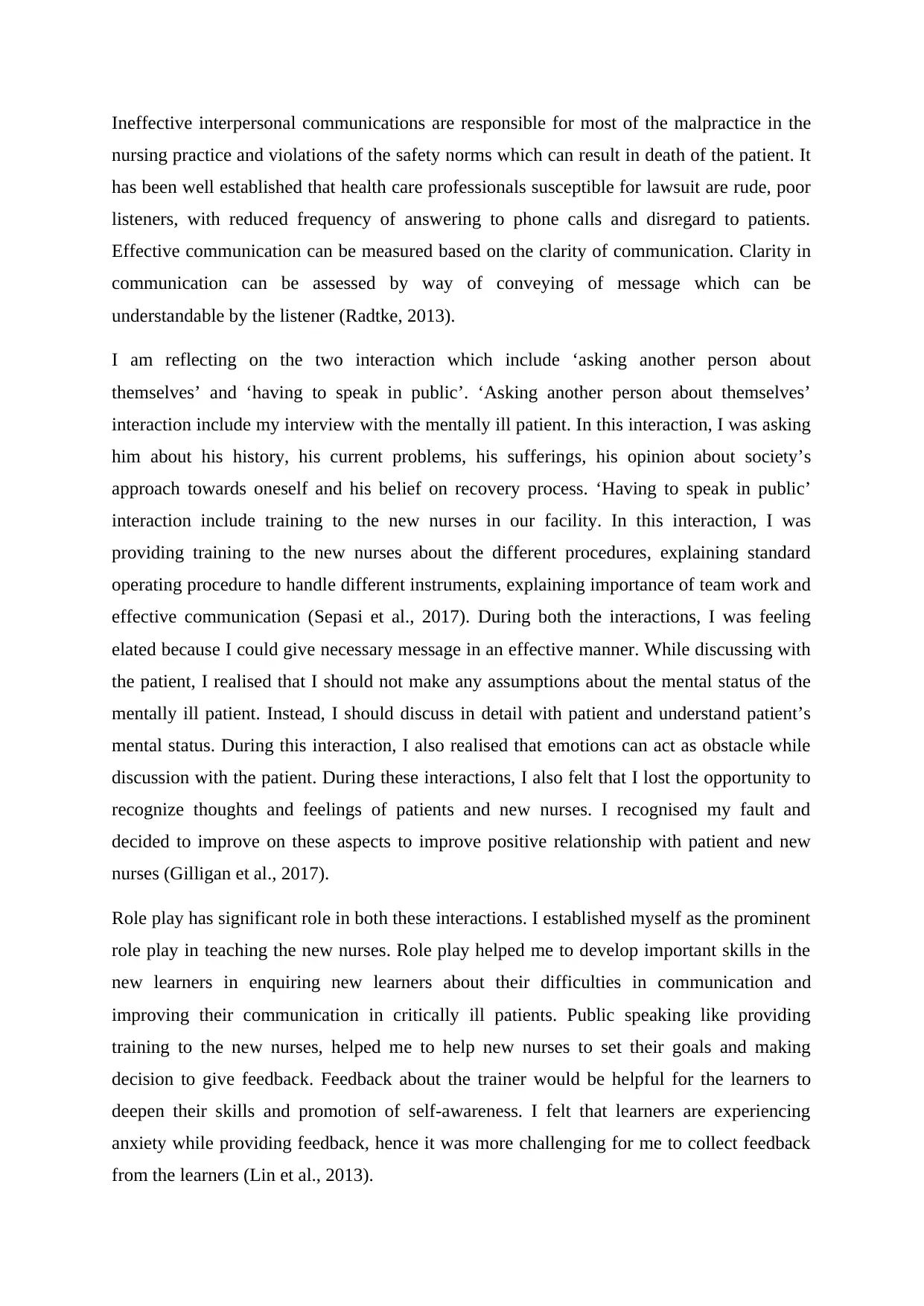
Ineffective interpersonal communications are responsible for most of the malpractice in the
nursing practice and violations of the safety norms which can result in death of the patient. It
has been well established that health care professionals susceptible for lawsuit are rude, poor
listeners, with reduced frequency of answering to phone calls and disregard to patients.
Effective communication can be measured based on the clarity of communication. Clarity in
communication can be assessed by way of conveying of message which can be
understandable by the listener (Radtke, 2013).
I am reflecting on the two interaction which include ‘asking another person about
themselves’ and ‘having to speak in public’. ‘Asking another person about themselves’
interaction include my interview with the mentally ill patient. In this interaction, I was asking
him about his history, his current problems, his sufferings, his opinion about society’s
approach towards oneself and his belief on recovery process. ‘Having to speak in public’
interaction include training to the new nurses in our facility. In this interaction, I was
providing training to the new nurses about the different procedures, explaining standard
operating procedure to handle different instruments, explaining importance of team work and
effective communication (Sepasi et al., 2017). During both the interactions, I was feeling
elated because I could give necessary message in an effective manner. While discussing with
the patient, I realised that I should not make any assumptions about the mental status of the
mentally ill patient. Instead, I should discuss in detail with patient and understand patient’s
mental status. During this interaction, I also realised that emotions can act as obstacle while
discussion with the patient. During these interactions, I also felt that I lost the opportunity to
recognize thoughts and feelings of patients and new nurses. I recognised my fault and
decided to improve on these aspects to improve positive relationship with patient and new
nurses (Gilligan et al., 2017).
Role play has significant role in both these interactions. I established myself as the prominent
role play in teaching the new nurses. Role play helped me to develop important skills in the
new learners in enquiring new learners about their difficulties in communication and
improving their communication in critically ill patients. Public speaking like providing
training to the new nurses, helped me to help new nurses to set their goals and making
decision to give feedback. Feedback about the trainer would be helpful for the learners to
deepen their skills and promotion of self-awareness. I felt that learners are experiencing
anxiety while providing feedback, hence it was more challenging for me to collect feedback
from the learners (Lin et al., 2013).
nursing practice and violations of the safety norms which can result in death of the patient. It
has been well established that health care professionals susceptible for lawsuit are rude, poor
listeners, with reduced frequency of answering to phone calls and disregard to patients.
Effective communication can be measured based on the clarity of communication. Clarity in
communication can be assessed by way of conveying of message which can be
understandable by the listener (Radtke, 2013).
I am reflecting on the two interaction which include ‘asking another person about
themselves’ and ‘having to speak in public’. ‘Asking another person about themselves’
interaction include my interview with the mentally ill patient. In this interaction, I was asking
him about his history, his current problems, his sufferings, his opinion about society’s
approach towards oneself and his belief on recovery process. ‘Having to speak in public’
interaction include training to the new nurses in our facility. In this interaction, I was
providing training to the new nurses about the different procedures, explaining standard
operating procedure to handle different instruments, explaining importance of team work and
effective communication (Sepasi et al., 2017). During both the interactions, I was feeling
elated because I could give necessary message in an effective manner. While discussing with
the patient, I realised that I should not make any assumptions about the mental status of the
mentally ill patient. Instead, I should discuss in detail with patient and understand patient’s
mental status. During this interaction, I also realised that emotions can act as obstacle while
discussion with the patient. During these interactions, I also felt that I lost the opportunity to
recognize thoughts and feelings of patients and new nurses. I recognised my fault and
decided to improve on these aspects to improve positive relationship with patient and new
nurses (Gilligan et al., 2017).
Role play has significant role in both these interactions. I established myself as the prominent
role play in teaching the new nurses. Role play helped me to develop important skills in the
new learners in enquiring new learners about their difficulties in communication and
improving their communication in critically ill patients. Public speaking like providing
training to the new nurses, helped me to help new nurses to set their goals and making
decision to give feedback. Feedback about the trainer would be helpful for the learners to
deepen their skills and promotion of self-awareness. I felt that learners are experiencing
anxiety while providing feedback, hence it was more challenging for me to collect feedback
from the learners (Lin et al., 2013).
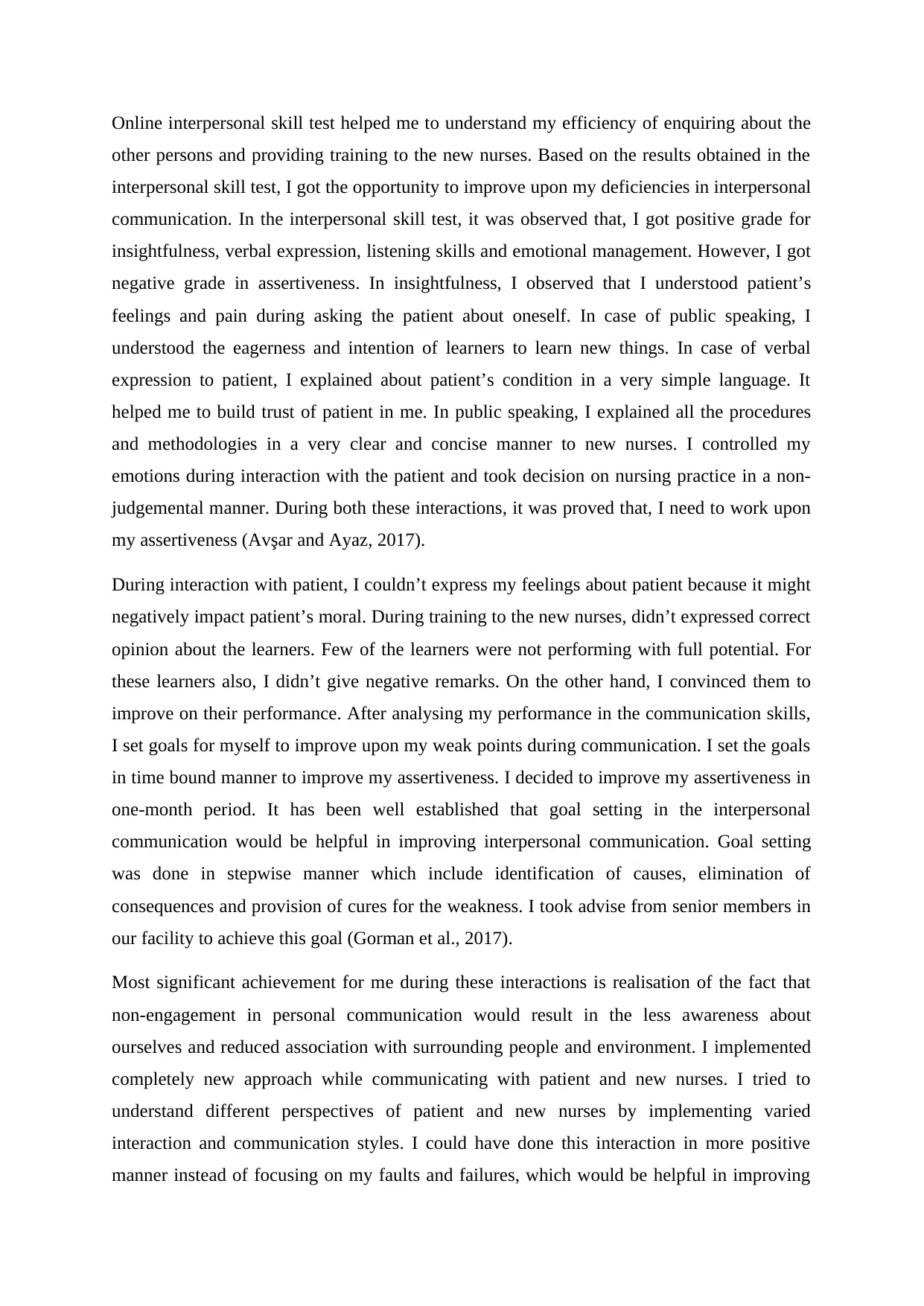
Online interpersonal skill test helped me to understand my efficiency of enquiring about the
other persons and providing training to the new nurses. Based on the results obtained in the
interpersonal skill test, I got the opportunity to improve upon my deficiencies in interpersonal
communication. In the interpersonal skill test, it was observed that, I got positive grade for
insightfulness, verbal expression, listening skills and emotional management. However, I got
negative grade in assertiveness. In insightfulness, I observed that I understood patient’s
feelings and pain during asking the patient about oneself. In case of public speaking, I
understood the eagerness and intention of learners to learn new things. In case of verbal
expression to patient, I explained about patient’s condition in a very simple language. It
helped me to build trust of patient in me. In public speaking, I explained all the procedures
and methodologies in a very clear and concise manner to new nurses. I controlled my
emotions during interaction with the patient and took decision on nursing practice in a non-
judgemental manner. During both these interactions, it was proved that, I need to work upon
my assertiveness (Avşar and Ayaz, 2017).
During interaction with patient, I couldn’t express my feelings about patient because it might
negatively impact patient’s moral. During training to the new nurses, didn’t expressed correct
opinion about the learners. Few of the learners were not performing with full potential. For
these learners also, I didn’t give negative remarks. On the other hand, I convinced them to
improve on their performance. After analysing my performance in the communication skills,
I set goals for myself to improve upon my weak points during communication. I set the goals
in time bound manner to improve my assertiveness. I decided to improve my assertiveness in
one-month period. It has been well established that goal setting in the interpersonal
communication would be helpful in improving interpersonal communication. Goal setting
was done in stepwise manner which include identification of causes, elimination of
consequences and provision of cures for the weakness. I took advise from senior members in
our facility to achieve this goal (Gorman et al., 2017).
Most significant achievement for me during these interactions is realisation of the fact that
non-engagement in personal communication would result in the less awareness about
ourselves and reduced association with surrounding people and environment. I implemented
completely new approach while communicating with patient and new nurses. I tried to
understand different perspectives of patient and new nurses by implementing varied
interaction and communication styles. I could have done this interaction in more positive
manner instead of focusing on my faults and failures, which would be helpful in improving
other persons and providing training to the new nurses. Based on the results obtained in the
interpersonal skill test, I got the opportunity to improve upon my deficiencies in interpersonal
communication. In the interpersonal skill test, it was observed that, I got positive grade for
insightfulness, verbal expression, listening skills and emotional management. However, I got
negative grade in assertiveness. In insightfulness, I observed that I understood patient’s
feelings and pain during asking the patient about oneself. In case of public speaking, I
understood the eagerness and intention of learners to learn new things. In case of verbal
expression to patient, I explained about patient’s condition in a very simple language. It
helped me to build trust of patient in me. In public speaking, I explained all the procedures
and methodologies in a very clear and concise manner to new nurses. I controlled my
emotions during interaction with the patient and took decision on nursing practice in a non-
judgemental manner. During both these interactions, it was proved that, I need to work upon
my assertiveness (Avşar and Ayaz, 2017).
During interaction with patient, I couldn’t express my feelings about patient because it might
negatively impact patient’s moral. During training to the new nurses, didn’t expressed correct
opinion about the learners. Few of the learners were not performing with full potential. For
these learners also, I didn’t give negative remarks. On the other hand, I convinced them to
improve on their performance. After analysing my performance in the communication skills,
I set goals for myself to improve upon my weak points during communication. I set the goals
in time bound manner to improve my assertiveness. I decided to improve my assertiveness in
one-month period. It has been well established that goal setting in the interpersonal
communication would be helpful in improving interpersonal communication. Goal setting
was done in stepwise manner which include identification of causes, elimination of
consequences and provision of cures for the weakness. I took advise from senior members in
our facility to achieve this goal (Gorman et al., 2017).
Most significant achievement for me during these interactions is realisation of the fact that
non-engagement in personal communication would result in the less awareness about
ourselves and reduced association with surrounding people and environment. I implemented
completely new approach while communicating with patient and new nurses. I tried to
understand different perspectives of patient and new nurses by implementing varied
interaction and communication styles. I could have done this interaction in more positive
manner instead of focusing on my faults and failures, which would be helpful in improving
⊘ This is a preview!⊘
Do you want full access?
Subscribe today to unlock all pages.

Trusted by 1+ million students worldwide
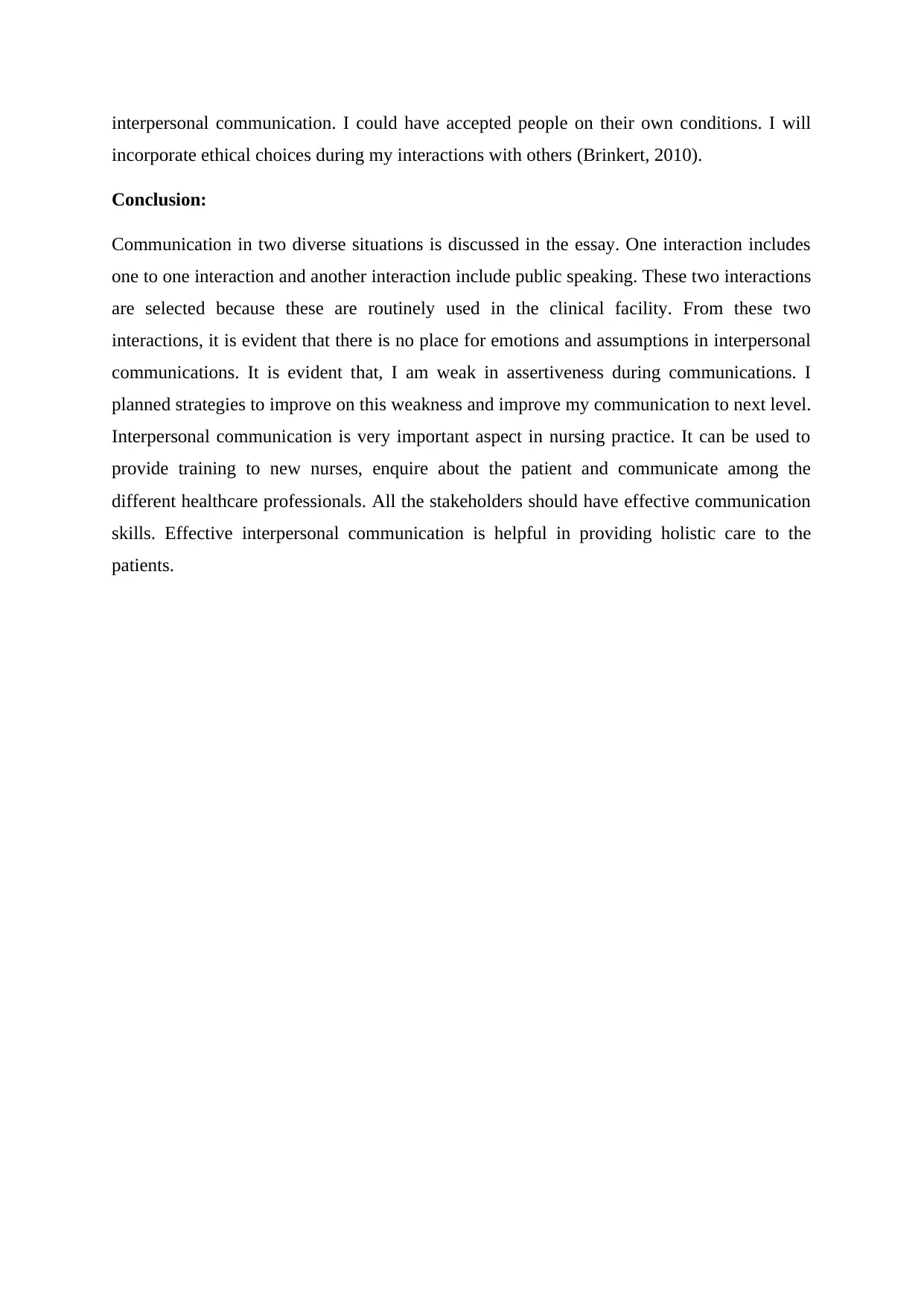
interpersonal communication. I could have accepted people on their own conditions. I will
incorporate ethical choices during my interactions with others (Brinkert, 2010).
Conclusion:
Communication in two diverse situations is discussed in the essay. One interaction includes
one to one interaction and another interaction include public speaking. These two interactions
are selected because these are routinely used in the clinical facility. From these two
interactions, it is evident that there is no place for emotions and assumptions in interpersonal
communications. It is evident that, I am weak in assertiveness during communications. I
planned strategies to improve on this weakness and improve my communication to next level.
Interpersonal communication is very important aspect in nursing practice. It can be used to
provide training to new nurses, enquire about the patient and communicate among the
different healthcare professionals. All the stakeholders should have effective communication
skills. Effective interpersonal communication is helpful in providing holistic care to the
patients.
incorporate ethical choices during my interactions with others (Brinkert, 2010).
Conclusion:
Communication in two diverse situations is discussed in the essay. One interaction includes
one to one interaction and another interaction include public speaking. These two interactions
are selected because these are routinely used in the clinical facility. From these two
interactions, it is evident that there is no place for emotions and assumptions in interpersonal
communications. It is evident that, I am weak in assertiveness during communications. I
planned strategies to improve on this weakness and improve my communication to next level.
Interpersonal communication is very important aspect in nursing practice. It can be used to
provide training to new nurses, enquire about the patient and communicate among the
different healthcare professionals. All the stakeholders should have effective communication
skills. Effective interpersonal communication is helpful in providing holistic care to the
patients.
Paraphrase This Document
Need a fresh take? Get an instant paraphrase of this document with our AI Paraphraser
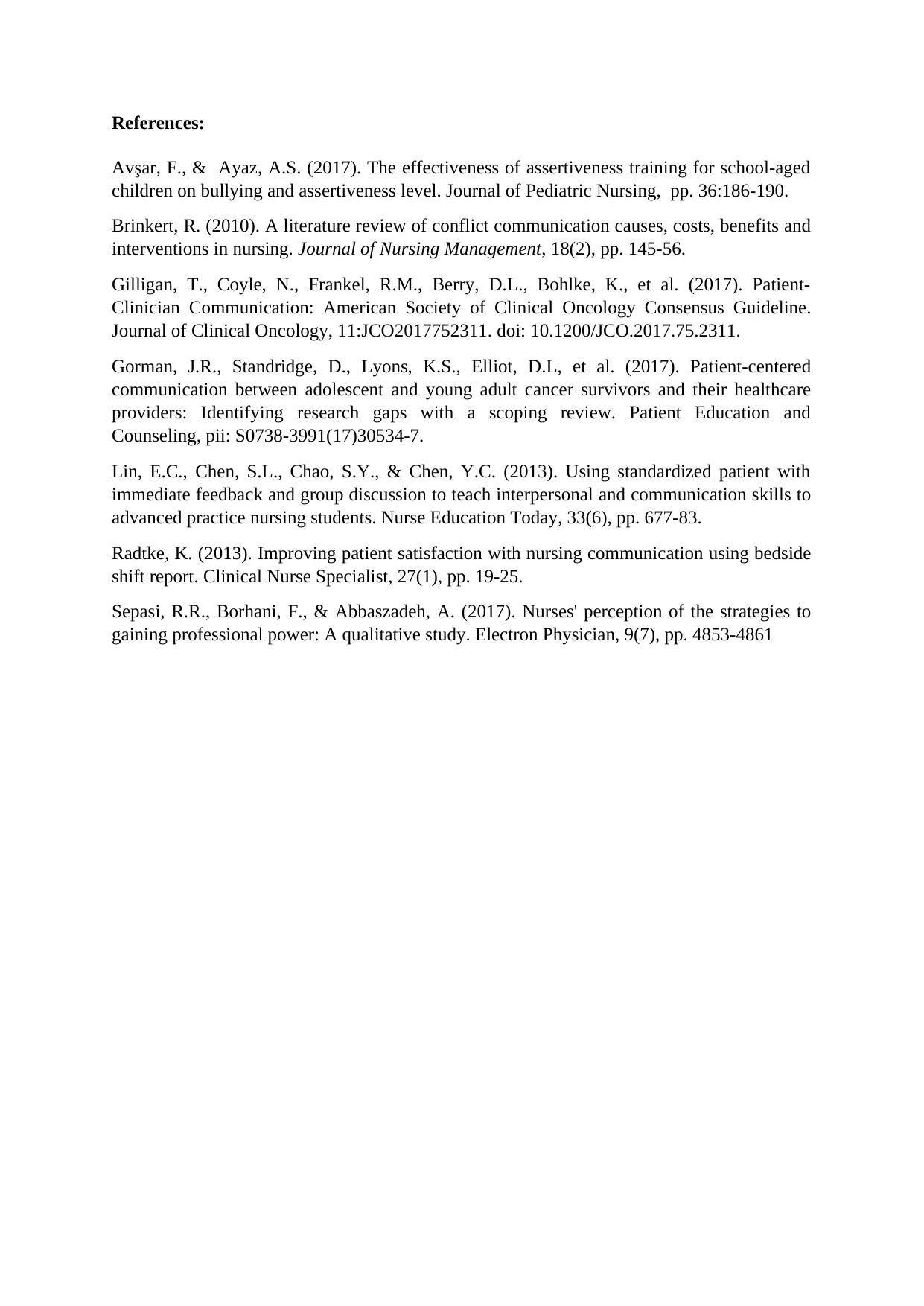
References:
Avşar, F., & Ayaz, A.S. (2017). The effectiveness of assertiveness training for school-aged
children on bullying and assertiveness level. Journal of Pediatric Nursing, pp. 36:186-190.
Brinkert, R. (2010). A literature review of conflict communication causes, costs, benefits and
interventions in nursing. Journal of Nursing Management, 18(2), pp. 145-56.
Gilligan, T., Coyle, N., Frankel, R.M., Berry, D.L., Bohlke, K., et al. (2017). Patient-
Clinician Communication: American Society of Clinical Oncology Consensus Guideline.
Journal of Clinical Oncology, 11:JCO2017752311. doi: 10.1200/JCO.2017.75.2311.
Gorman, J.R., Standridge, D., Lyons, K.S., Elliot, D.L, et al. (2017). Patient-centered
communication between adolescent and young adult cancer survivors and their healthcare
providers: Identifying research gaps with a scoping review. Patient Education and
Counseling, pii: S0738-3991(17)30534-7.
Lin, E.C., Chen, S.L., Chao, S.Y., & Chen, Y.C. (2013). Using standardized patient with
immediate feedback and group discussion to teach interpersonal and communication skills to
advanced practice nursing students. Nurse Education Today, 33(6), pp. 677-83.
Radtke, K. (2013). Improving patient satisfaction with nursing communication using bedside
shift report. Clinical Nurse Specialist, 27(1), pp. 19-25.
Sepasi, R.R., Borhani, F., & Abbaszadeh, A. (2017). Nurses' perception of the strategies to
gaining professional power: A qualitative study. Electron Physician, 9(7), pp. 4853-4861
Avşar, F., & Ayaz, A.S. (2017). The effectiveness of assertiveness training for school-aged
children on bullying and assertiveness level. Journal of Pediatric Nursing, pp. 36:186-190.
Brinkert, R. (2010). A literature review of conflict communication causes, costs, benefits and
interventions in nursing. Journal of Nursing Management, 18(2), pp. 145-56.
Gilligan, T., Coyle, N., Frankel, R.M., Berry, D.L., Bohlke, K., et al. (2017). Patient-
Clinician Communication: American Society of Clinical Oncology Consensus Guideline.
Journal of Clinical Oncology, 11:JCO2017752311. doi: 10.1200/JCO.2017.75.2311.
Gorman, J.R., Standridge, D., Lyons, K.S., Elliot, D.L, et al. (2017). Patient-centered
communication between adolescent and young adult cancer survivors and their healthcare
providers: Identifying research gaps with a scoping review. Patient Education and
Counseling, pii: S0738-3991(17)30534-7.
Lin, E.C., Chen, S.L., Chao, S.Y., & Chen, Y.C. (2013). Using standardized patient with
immediate feedback and group discussion to teach interpersonal and communication skills to
advanced practice nursing students. Nurse Education Today, 33(6), pp. 677-83.
Radtke, K. (2013). Improving patient satisfaction with nursing communication using bedside
shift report. Clinical Nurse Specialist, 27(1), pp. 19-25.
Sepasi, R.R., Borhani, F., & Abbaszadeh, A. (2017). Nurses' perception of the strategies to
gaining professional power: A qualitative study. Electron Physician, 9(7), pp. 4853-4861
1 out of 5
Related Documents
Your All-in-One AI-Powered Toolkit for Academic Success.
+13062052269
info@desklib.com
Available 24*7 on WhatsApp / Email
![[object Object]](/_next/static/media/star-bottom.7253800d.svg)
Unlock your academic potential
Copyright © 2020–2025 A2Z Services. All Rights Reserved. Developed and managed by ZUCOL.





